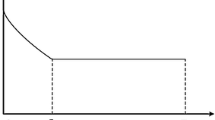Abstract
When a product is purchased and used by a customer then it might be possible that a difference between the product performance and customer expectation crops in. A warranty is simply a formal promise by a vendor that the product is defect free, meaning that it will do what it promises to do and that if it fails to do so, then how the vendor will go about rectifying defects. Warranties are also an effective means of promoting a product in the market when the company or product is not well known. Or in other words warranty serves as a source for spread of an innovation in the market. But servicing a warranty engages additional costs to the manufacturer and this has an effect on the profit levels. Warranty cost may be reduced by providing higher reliable product. The conflict existing in the context of software reliability, warranty period and selling price need to be considered jointly. In this paper, we formulate an optimization problem that determines the optimal testing time and price under two types of imperfect debugging of software product with warrant. The factors like fixed cost of testing and debugging during testing phase and warranty period, cost of testing up to the release time are considered in order to maximize profit. Results are illustrated in the numerical example.
Similar content being viewed by others
Abbreviations
- a :
-
Expected number of faults in the software
- b :
-
Proportionality constant
- m f (t):
-
Expected number of faults detected in the interval (0, t]
- m r (t):
-
Expected number of faults removed in the interval (0, t]
- T :
-
Total testing time
- W :
-
Warranty period
- p :
-
Probability of perfect debugging of a fault (0 < p < 1)
- ɛ :
-
Rate at which faults are introduced during the debugging process(0 < ɛ < 1)
- C 0 :
-
Set-up cost for software development
- C 1(C 1′):
-
Cost incurred on a perfect (Imperfect) debugging of fault during testing
- C 2(C 2′):
-
Cost incurred on a perfect (Imperfect) debugging of fault during warranty period(C 2 > C 1, C 2′ > C 1′)
- C 3 :
-
Software testing cost per unit testing time
References
Bittanti et al (1988) A flexible modeling approach for software reliability growth. In: Goos G, Harmanis J (eds) Software reliability modelling and identification. Springer, Berlin, pp 101–140
Boehm BW (1981) Software engineering economics, Englewood cliffs. Prentice-Hall, Upper Saddle River
Boehm BW et al (1996) The COCOMO 2.0 software cost estimation model. Am Program July:2–17
Cantone G, Cimitile A, De Carlini U (1986) A comparison of models for software cost estimation and management of software projects”, in computer systems: performance and simulation. Elsevier, Amsterdam
Goel AL (1985) Software reliability models: assumptions. Limit Appl IEEE Trans Softw Eng SE-11:1411–1423
Goel AL, Okumoto K (1979) Time dependent error detection rate model for software reliability and other performance measures. IEEE Trans Reliab R-28(3):206–211
Kapur PK, Garg RB (1990) Optimal software release policies for software reliability growth model under imperfect debugging. RAIRO 24:295–305
Kapur PK, Garg RB (1992) A software reliability growth model for an error-removal phenomenon. Softw Eng J 7:291–294
Kapur PK, Kumar D, Gupta A, Jha PC (2006) On how to model software reliability growth in the presence of imperfect debugging and error generation. In: Proceedings of 2nd international conference on reliability and safety engineering, pp 515–523
Kapur PK, Gupta D, Gupta A, Jha PC (2007) Effect of Introduction of faults and imperfect debugging on release time. Ratio Mathematica 18:62–90
Kapur PK, Pham H, Gupta A, Jha PC (2011) Software reliability assessment with OR applications. Springer, Berlin
Ladany Shaul P, Shore Haim (2007) Profit maximizing warranty period with sales expressed by a demand function. Qual Reliab Eng Int 23:291–301
Lyu MR (ed) (1996) Handbook of software reliability engineering. McGraw Hill, New York
Ohba M (1984) Inflection S-shaped software reliability growth models. In: Osaki S, Hatoyama Y (eds) Stochastic models in reliability theory. Springer, Berlin, pp 44–162
Ohba M, Chou XM (1989) Does imperfect debugging effect software reliability growth. In: Proceedings of 11th international conference of software engineering, pp 237–244
Pham H (2006) System software reliability. Springer, Berlin
Wood A (1996) Predicting software reliability. IEEE Comput 11:69–77
Yamada S (1994) Optimal release problems with warranty period based on a software maintenance cost model. Trans IPS Jpn 35(9):2197–2202
Yamada S, Obha M, Osaki S (1983) S-shaped software reliability growth modeling for software error detection. IEEE Trans Reliab 32(5):475–484
Zhang X, Teng X, Pham H (2003) Considering fault removal efficiency in software reliability assessment. IEEE Trans Syst Man Cybern A 33(1):114–120
Author information
Authors and Affiliations
Corresponding author
Rights and permissions
About this article
Cite this article
Kapur, P.K., Singh, O. & Shrivastava, A.K. Optimal price and testing time of a software under warranty and two types of imperfect debugging. Int J Syst Assur Eng Manag 5, 120–126 (2014). https://doi.org/10.1007/s13198-014-0221-x
Received:
Published:
Issue Date:
DOI: https://doi.org/10.1007/s13198-014-0221-x




